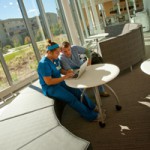Cover story: Home sweet MOSDOH
Posted: November 11, 2013
Home is where the heart is
At 8:00 a.m. on Oct. 1, 42 eager dental students began their first day of classes at the Missouri School of Dentistry & Oral Health*. After more than three years of preparation and paperwork, conversations and construction, the inaugural class finally settled into their new home on the Missouri campus. Filing into the Interprofessional Education (IPE) Building, the new 42 were greeted by a welcoming committee led by MOSDOH Dean Christopher Halliday, DDS, MPH, who couldn’t restrain his excitement or his permanent smile.
“I am going to interact with students,” Dr. Halliday says. “I want their feedback. I want them to feel that they’re a part of this dental school, not only as students, but also part of making this school as successful as any dental school could hope to be.”
Dr. Halliday spent Day No. 1 with his new family of students, conversing with faculty, and even attending classroom lectures. If engagement is the goal, MOSDOH’s inaugural dean has it covered.

D1s at orientation
“It will be hands-on; I want it to be a collegial environment,” Dr. Halliday continues. “The learning environment here will be cool because it won’t be the typical higher education instruction where students are lectured to. We’re going to make sure our instructors are interactive with students. Students are going to know how to apply this information, and the instructors will not only instruct, but also facilitate the learning process. We’re going to make sure students know the material well enough that they can converse amongst themselves and apply this information.”
Because the class of 2017 started late in the year, a compressed schedule means there is a large amount of information for D1s to process quickly. The daily grind of graduate school has a reputation for leaving students exhausted and disenchanted with their profession. But, promises President Craig M. Phelps, DO, ’84, that is not the ATSU way.
“The people around you, in front of you, behind you … You are going to be friends for life,” Dr. Phelps assures students in his welcome address. “In fact, in Arizona [at ATSU’s Arizona School of Dentistry & Oral Health], they call it ‘the happy dental school.’”
Home away from home
Looking around at MOSDOH’s new digs, it’s hard to imagine anything but happiness and rays of sunshine for its first class.
The IPE Building, with its state-of-the-art equipment, has ample space to accommodate MOSDOH and KCOM students, plus room to grow. Having both the dental and osteopathic medical professions under one roof to promote collaboration afforded the building its name and played a key role in its design.
Now a sparkling sight to behold, the IPE Building’s curvaceous exterior and skyward reaching windows, eye-popping canary yellow glass walls, and ultramodern simulation labs were nothing more than a grey parking lot just 1 ½ years ago. St. Louis firm Cannon Design brought ATSU’s grand vision from blueprints to a 62,000-square-foot dental student hot spot.

Rain drizzles on Elizabeth Desamero, D1, and her family at the White Coat Ceremony, held Sept. 28.
The main floor focal point is the Dental Simulation Laboratory. Here, the building’s hands-free energy management system senses when someone has entered the room by slowly turning up the lights. The lab also is bathed in natural light, with three of four walls being floor to ceiling windows, making it the perfect spot for practicing dental restoration and appliance color matches.
Row after row of KaVo brand dental mannequins—48 to be exact—are flanked by large screen projection monitors that help students easily follow along with their instructor. The action is simultaneously displayed on personal monitors at each workstation.
A wet lab spans the back wall. To the back left is a separate fourchair training area for students to learn digital X-ray techniques, dental hygiene instrumentation, dental anesthesia, and other intraoral procedures on classmates.
Students learn all aspects of dental procedures in the lab, such as how to perform fillings and root canals, as well as place implants, before advancing to a live patient care setting in their third and fourth years.
“The technology is impressive,” says Dr. Halliday, “and will allow students to best simulate the patient in a treatment situation before they ever actually treat a patient. This facility will not only replicate the actual procedures involved in dental treatment, but also will replicate the entire patient process. Our students will relate to simulation mannequins as if they are actual human beings. They will get a very accurate clinical experience while in the simulation lab.”

ATSU President Emeritus W. Jack Magruder and First Lady Emerita Sue Magruder are filled with joy at Dr. Phelps’ surprise announcement at
MOSDOH’s Inauguration
Ceremony that the Interprofessional Education Building lobby will be named in their honor.
Trekking up the winding glass staircase, the IPE Building’s second floor does not disappoint. Hard-to-miss free-standing walls of frosted yellow glass make up a conference room that mirrors that of the first floor’s. Half of the upstairs is devoted to human patient simulator (HPS) break-out rooms and a classroom for KCOM students. HPSs previously lived in the Connell Information Technologies Center (CITC). Having relocated, the CITC now has space for a new ultrasound lab.
First-year student Zane Lambert is awestruck by the space.
“My initial thought was that I could not believe they built this for us,” he says. “For a school to provide so much of its resources to a building this technologically advanced indicated to me that ATSU was fully invested in this new dental program.”
Every inch of the IPE Building is designed so intricately and modernly, it’s almost as if it were transported from some futuristic land of science fiction. But the innovative building is just the backdrop to the innovative core curriculum dental students will learn. Central to that curriculum is extensive, in-depth clinical training at community health centers (CHCs).
Dental training hits home
In Missouri, CHCs care for 420,000 vulnerable residents, or 25 percent of the total number of low-income and uninsured citizens. During students’ third- and fourth-years, they will be embedded inside Missouri CHCs where they will treat patients under faculty dentist supervision. Students will be involved in every aspect of dental care from prevention to rehabilitation. They will work with the full spectrum of underserved patients including children, adults, geriatric patients, the disabled, the homeless, and the uninsured. This will allow CHCs to reach an astounding additional 11,500 patients each year.
MOSDOH’s most comprehensive CHC relationship will be with St. Louis’ Grace Hill Health Centers Inc. (GHHC), which provides primary medical, dental, and behavioral health services to a large segment of the city’s low-income and uninsured population. Beginning in the summer of 2015, GHHC, in partnership with ATSU, will operate an expansive new 93-operatory dental clinic. After spending two years on the Missouri campus, students will relocate to St. Louis for third-year clinical experiences at the ATSU-GHHC-operated clinic. During their fourth-year, students will divide time between St. Louis and additional CHC partner locations throughout Missouri and the Midwest.
Interestingly, CHC on-site clinical education was identified in a 2011 Institute of Medicine (IOM) report as the most effective way to break down barriers to care faced by underserved populations. Although MOSDOH was not intentionally responding to the report in the development of its curriculum, Dean Halliday feels that it just solidifies the direction the School is heading.
“The Institute of Medicine made several recommendations related to dental education systems, and everything they mentioned was incorporated into this School,” he says. “We are on the same wavelength.”

Custom made in West Germany, the equipment in the Dental Simulation Laboratory has “all the bells and whistles.” Each dental student is assigned a workstation, which includes a lifelike mannequin, LED chairside dental light, lab bench, and storage space for dental instruments and materials.
In their report, IOM finds an improved and responsive dental education system is needed to ensure that dental professionals can deliver quality care to diverse populations in a variety of settings, using a variety of service-delivery mechanisms. MOSDOH’s curricular model ensures its dental professionals will develop the necessary skills to work in a variety of community-based settings with disadvantaged populations, including the ability to work in interprofessional teams with general health, education, and social service professionals.
Partnerships with CHCs are expected to increase retention within the state’s oral health workforce by encouraging graduates to practice public health dentistry. Fittingly, MOSDOH graduates will earn a certificate of public health (with the option of pursuing a master’s degree in public health) in addition to a doctor of dental medicine degree, differentiating the School from any other in the Midwest. This will prepare a workforce uniquely qualified to care for diverse, underserved populations.
With a mission to increase access to oral healthcare for Missouri’s most vulnerable populations, MOSDOH couldn’t have opened its doors at a better time. The number of dentists in the state is declining, while the needs of underserved populations and demand for dentists are rising. According to the U.S. Department of Health and Human Services, only 13 of 114 Missouri counties have enough dentists, and the state ranks 41st in the nation in adult oral health and 49th in the nation in children’s oral health based on the percentages of those who regularly visit the dentist. In 28 counties, at least 50 percent of dentists plan to retire within 10 years. It’s an urgent situation, and what’s more, there seems to be little acknowledgment by Missourians that poor oral health can negatively impact overall health.
WEB EXCLUSIVE: Want more MOSDOH? Get exclusive content—photos, events, quotes, media coverage, and more …
Still Magazineatsu.edu/?p=3981#more-3981
“I’d like people to understand that the science and literature show strong relationships between oral health and overall health,” says Dr. Halliday, who mentions correlations to diabetes and heart disease. “Increasing access to dental care will improve overall health. We’re not just dealing with good-looking smiles and toothaches; we’re improving the overall health of all these people.”
It takes a village to raise a dental school
An upswell of community support helped MOSDOH establish its home in Northeast Missouri. A grassroots effort led by Community Friends for ATSU Dental raised more than $1.1 million to make the case for the new dental program to be located in Kirksville. Initially, ATSU was propositioned by groups in three states, each wanting the University to replicate its innovative community-focused dental school model.

Sleek, curvy furniture defines student seating areas on floors 1 and 2, with inspiring views that look across the Missouri campus.
A three-year $3 million grant courtesy of the Missouri Foundation for Health funded curriculum development, payroll expenses, and equipment.
“They’ve been an early believer in this,” says Dr. Halliday. “They are impressed with the University’s desire to increase access to care for underserved populations.”
Another vital partner has been the Missouri Primary Care Association (MPCA). This relationship helped establish 14 CHC affiliation agreements for the training of fourth-year students.
“This curriculum, with its emphasis on placing students inside the communities most in need, reflects the out-of-the-box thinking needed to fix the problem here in Missouri and around the country,” says MPCA CEO Joseph E. Pierle.
“ATSU is excited to educate the next generation of dentists in an environment dedicated to the principles established more than 120 years ago by Dr. A.T Still. The citizens of Kirksville have been welcoming medical students for generations and have extended the same hospitality to our dental students, faculty, and staff,” says President Phelps. “Our University alumni, students, faculty, and staff can be proud of the opening of America’s newest dental school and the positive impact it will have on the lives of patients and communities.”
There’s no place like home
Oct. 1 marked a momentous occasion at ATSU—the day everyone has been literally waiting for since talks of a new dental program began in 2010. Now that its doors are finally open and classes are in session, MOSDOH is perfectly positioned to raise the standard in Missouri’s oral health through service to community, increasing access to care, and decreasing oral health disparities among disadvantaged populations.
The ATSU family is proudly growing—a sixth school, new students, an expanding campus—and Missouri has welcomed it all with open arms. Settling into their cozy new space for the next two years, MOSDOH’s inaugural class of students shares the same sentiment: There’s no place like home.
*At its August 2013 meeting, the Commission on Dental Accreditation adopted a resolution to grant initial accreditation to MOSDOH and its developing program in dental education. After MOSDOH graduates its first class in 2017, the School will be eligible for full accreditation by CODA. At that point, MOSDOH may consider increasing its class size from 42 to 60 students.
Roll call with a D1

Zane Lambert, D1. Selected from 954 applicants, the inaugural MOSDOH student body is comprised of 42 students—22 women and 20 men from 19 states, including nine from Missouri.
Here, we catch up with Colorado Springs, Colo., native Zane Lambert, D1, great-grandson of ASO (now KCOM) alumnus Lester C. Lambert, DO, ’16, whose diploma was signed by none other than ATSU founder Dr. A.T. Still.
Why did you choose MOSDOH?
The main reason was the feeling I received from the people who work here. On interview day, the staff was so friendly and inviting. They never acted like I needed to gain their approval because I was already their friend. And, it is pretty cool to say you were part of an inaugural class to graduate from dental school. To help mold a program for future generations is an awesome responsibility.
How did you feel when you received your white coat?
The White Coat Ceremony hit me with a flood of emotion. I was mostly elated that I had been warmly accepted into a caring profession and a nurturing school. But several other feelings were definitely prominent. The white coat had a distinct weighty feel. When Dean Halliday assisted me with putting on my coat, I swear I could feel the weight of my future patients’ concerns put upon my shoulders. That pivotal moment was a sobering experience. Questions began swirling around in my head: “Will I be as good of a dentist as I have imagined I will be? Will I be considered gentle? Will I heal the sick as effectively as I should?”
How was your first day of class?
It was a lot of fun. Getting to know my classmates was very exciting. We have such a great, diverse class, and we already have an unofficial motto: “Together we will.” I have been most impressed with the instantaneous synergy our class has effortlessly developed.
What are you most excited about now that you are a dental student?
I think the best part about being a dental student is the fact that I now have a legitimate reason to squirt someone with the irrigation gun and not get in trouble. In all seriousness, I am very excited to be hyper-focused on learning the science and techniques of dentistry. Becoming a dental student means I am just one small step closer to being able to care for people who otherwise would not be able to care for themselves.
Do you feel you are carrying on a legacy for your family?
Although I never met my great-grandfather, the stories I have heard about him leave little doubt that I would have liked him very much. In his ASO yearbook, my great-grandfather was considered joyful and a “care-free fellow” … adjectives I think my fellow peers would use to describe me. While I am proud to return to an institution once home to a family member, I feel more strongly connected to the legacy A.T. Still began more than a century ago.
The big question: Why a dental school in Missouri?
Answered by Christopher Halliday, DDS, MPH, dean, MOSDOH

The sincerely altruistic Dr. Halliday has spent his career caring for the underserved in Alaska, New Mexico, and Arizona, and advocating on their behalf, most recently as chief of staff to the U.S. surgeon general. “I have always believed in being an advocate for those who are less fortunate,” he says.
There are huge access to care challenges for citizens in the state of Missouri, and there are huge oral health disparities experienced statewide. Comparing people from Missouri to people throughout the country, Missourians tend to have more dental disease and more difficulty gaining access to a dentist. Everything just adds up. There was a huge unmet need in the state and a huge interest to have a dental school in the state.
What challenges to oral health do Missourians face?
Of all 50 states rated by [The Pew Charitable Trusts Center on the States*], Missouri ranked 41st in the percentage of adult residents able to visit a dentist and 49th in the percentage of children that received any type of dental services. Seventy-two percent do not have dental insurance coverage. Missouri has six counties in the state with no dentists at all and 12 counties with only one dentist. The federal government looked at the state of Missouri and 101 of 114 counties were designated as dental health professional shortage areas or had areas within the county that were designated as dental health professional shortage areas.
How soon will MOSDOH students be able to affect a positive change for Missourians?
In the curriculum model, students will do all their preclinical training in Kirksville for the first two years of school. Starting in year three, they take all their clinical skills to St. Louis, working in the facility operated in partnership with Grace Hill. During the final year of dental school, approximately half of the fourth-year class will rotate to other community health center settings throughout the state while the other half stays at the St. Louis facility. [By 2015], they will be increasing access to care to oral health services throughout the state of Missouri through additional community health center partners. I wouldn’t underestimate the importance of making sure we have students out there serving the needs of safety net clinics.
Why was St. Louis’ Grace Hill Health Centers Inc. chosen as MOSDOH’s primary clinical rotation site?
As the largest metropolitan area in the state and one of Missouri’s most underserved urban environments, St. Louis does not have a dental school clinic to provide care to its diverse population groups. There have been dental schools there in the past, but they have closed. Our desire is to build a two-story dental clinic of approximately 93 chairs at a site near Lafayette Square. The facility will be operated in partnership with Grace Hill Health Centers Inc., the largest community health center group in Missouri. ATSU will be responsible for the educational component of the students, but Grace Hill will bring the community health center experience to our students and will manage day to day clinical operations. Grace Hill will bring along a diverse and large patient population for our students, and our students in turn will assist Grace Hill by helping increase access to oral health services to the communities served by Grace Hill.
How is MOSDOH unique compared to ATSU’s Arizona School of Dentistry & Oral Health?
MOSDOH is built upon the Arizona model, but it is unique. MOSDOH has established its own identity and has its own personality. The main difference is that our students will do 100 percent of their clinical training in community health center settings. We do not have a clinic on site. That, by nature, means they’ll be serving underserved, underinsured, and disadvantaged populations.
*The Pew Charitable Trusts is an independent nonprofit organization.